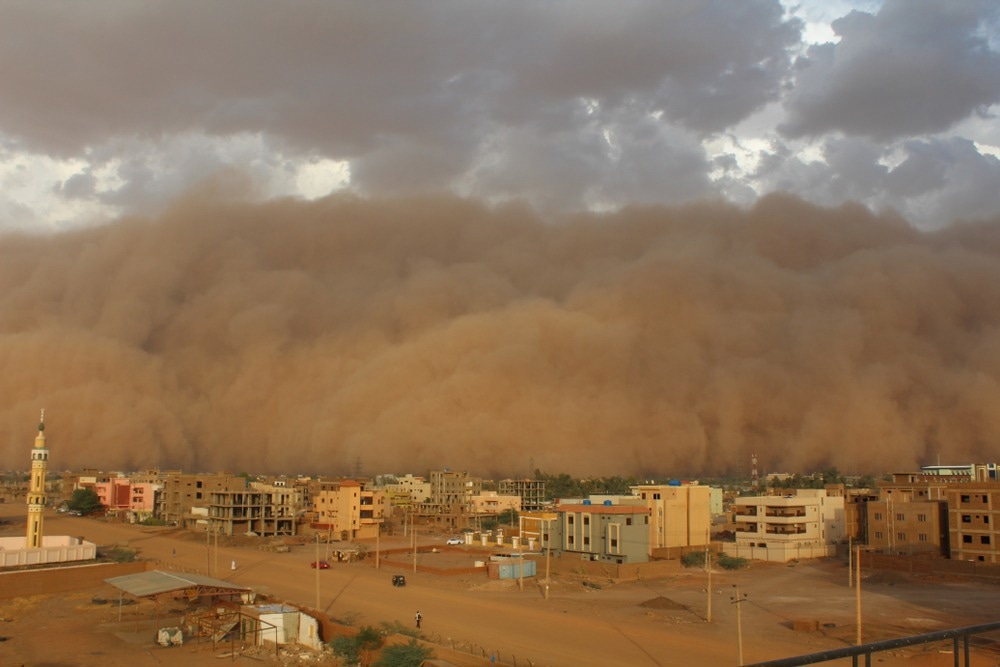In a study published in the journal Remote Sensing, the researcher observed dust in Jinan, China, to investigate a strong sandstorm. They used MODIS, MPL lidar, EDM 180, ADI 2080, meteorological observation instruments, and the HYSPLIT model to find the source.

Study: Characterizing a Heavy Dust Storm Event in 2021: Transport, Optical Properties and Impact, Using Multi-Sensor Data Observed in Jinan, China. Image Credit: Omer koclar/Shutterstock.com
Sandstorm Overview
Eolian erosion in dry and semi-arid regions causes dust aerosols to be released. These dust aerosols are vertically injected into the atmosphere to travel great distances. Mineral dust is the most prevalent component in atmospheric aerosol when measured in terms of its dry aerosol mass.
Dust particles play a significant function in the atmospheric radiation budget and hydrological cycles due to their radiative and cloud condensation nucleus effects. These effects also have a considerable influence on the changes in climate and the environment. At the same time, dust particles represent a substantial risk to the health of humans and the ecology.
Severe Dust Storm in China
The most severe dust weather event hit China in the last decade on March 15, 2021. There were several locations in northern China where the peak concentration of particulate matter (PM) was more than 5000 g/m3, the highest value seen since 2013.
On March 15, the visible dust area expanded to a total of 466,000 km2, according to the monitoring done by the meteorological satellite FY-4.
It is essential to characterize this dust event to properly evaluate the effects of dust aerosol on radiation–cloud–climate and the air quality in the area.
Previous Research Regarding This China Sandstorm Event
Several studies have been conducted to identify various aspects of the Chinese sandstorm event.
Previous researchers has identified the origins of sand, investigated the factors that contribute to dusty weather by employing several techniques, collected dust samples from different cities, and investigated dust emission and transport processes by analyzing how the composition of dust substances shifts over time.
However, previous studies have not covered dust's optical properties and influences. This study fills this gap by analyzing dust characteristics using the data observed via lidar and other platforms in Jinan.
How the Research was Carried Out
Instruments and methods can be characterized in three distinct parts, i.e. ground-based instruments, satellite remote sensing instrument-MODIS, and backward trajectory modeling system-HYSPLIT.
Micro Pulse Lidar (MPL)
Micro pulse lidar located in Huaiyin District of Jinan was operated in verticle pointing mode. The study used the lidar's volume depolarization ratio (VDR) and the extinction coefficient. VDR is used to differentiate between urban pollutants and dust, whereas the extinction coefficient reflects the degree of particulate pollution.
Environmental Dust Monitor (EDM)
EDM 180 installed on Guishan, Jinan, was used to extract the particle concentration data. It continuously measures the particle size distribution of dust in air based on the light scattering principle.
Monitor for Aerosols and Gases in Ambient Air (MARGA)
Changes in aerosol particle composition in dust weather were analyzed by MARGA located in Shandong Jianzhu University.
The output results of this instrument included the mass concentration of gases ( NH3, SO2, HNO3, HNO2, and HCL) and water-soluble ions (Mg2+, Ca2+, K+, Na+, NH4+. SO2 2-, NO3 -. Cl-).
Satellite Remote Sensing Instrument (MODIS)
MODIS is a large space remote sensing instrument that can provide information regarding cloud-top height, ozone, atmospheric temperature, cloud top temperature, surface temperature, atmospheric water vapor, chemistry, biogeography, phytoplankton, ocean water color, cloud characteristics, cloud boundary and land surface conditions.
Backward Trajectory Modeling System (HYSPLIT)
The researchers used the Hybrid Single-Particle Lagrangian Integrated Trajectory Model (HYSPLIT), an atmospheric transport and dispersion model that runs via the Real-Time Environmental Applications and Display System (READY) tool to trace the sources of dust.
Important Findings of the Study
The researchers concluded that cold and high-pressure air after a strong Mongolian cyclone raised the dust and moved it eastward and southward regions in China, affecting the local air quality.
The backward trajectory maps showed that the transport paths of dust were not identical on variable heights. Jinan was first affected by the dust from the Gobi desert and south and west regions of Mongolia, and then it came from the eastern parts of Mongolia.
The Observed VDR value of the dust was between 0.1 and 0.2. VDR and transport height were inversely proportional, indicating that the upper layer had smaller sand particles than the lower layers.
MODIS measured dust's angstrom exponent (AE) value to be less than 0.25. Aerosol optical depth and extinction coefficient were directly proportional to dust intensity.
Dust pollution impacted particles' characterization. For example, the number concentrations of particles showed that the particles with a size larger than 0.58 micros expanded abruptly, whereas between 0.25 and 0.58 micros significantly reduced.
Air temperature and weather constituents were also affected by the dust. In the early dust stage, the air pressure decreased significantly, while the relative humidity decreased after dust. In the dust weather process, the temperatures remain lower in the daytime and higher at night.
Reference
Aiqin Tu, Zhenzhu Wang, Zhifei Wang, Wenjuan Zhang, Chang Liu, Xuanhao Zhu, Ji Li, Yujie Zhang, Dong Liu and Ningquan Weng (2022) Characterizing a Heavy Dust Storm Event in 2021: Transport, Optical Properties and Impact, Using Multi-Sensor Data Observed in Jinan, China. Remote Sensing. https://www.mdpi.com/2072-4292/14/15/3593/htm
Disclaimer: The views expressed here are those of the author expressed in their private capacity and do not necessarily represent the views of AZoM.com Limited T/A AZoNetwork the owner and operator of this website. This disclaimer forms part of the Terms and conditions of use of this website.